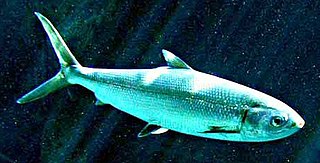
The Gonorynchiformes are an order of ray-finned fish that includes the important food source, the milkfish, and a number of lesser-known types, both marine and freshwater.

The milkfish is the sole living species in the family Chanidae. However, there are at least five extinct genera from the Cretaceous. The repeating scientific name (tautonym) is from Greek khanos.

Chanidae is a family of fishes which has a number of fossil genera and one monotypic extant genus which contains the milkfish.

Simosuchus is an extinct genus of notosuchian crocodylomorphs from the Late Cretaceous of Madagascar. It is named for its unusually short skull. Fully grown individuals were about 0.75 metres (2.5 ft) in length. The type species is Simosuchus clarki, found from the Maevarano Formation in Mahajanga Province, although one isolated multicuspid tooth of this genus was discovered in Kallamedu Formation of India.
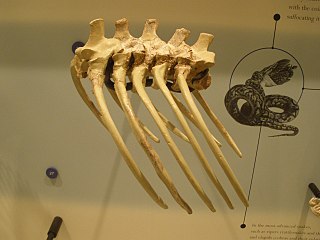
Madtsoiidae is an extinct family of mostly Gondwanan snakes with a fossil record extending from early Cenomanian to late Pleistocene strata located in South America, Africa, India, Australia and Southern Europe. Madtsoiidae include very primitive snakes, which like extinct boas and pythons would likely dispatch their prey by constriction. Genera include Madtsoia, one of the longest snakes known, at an estimated 10 metres (33 ft), and the Australian Wonambi and Yurlunggur. As a grouping of basal forms the composition and even the validity of Madtsoiidae is in a state of flux as new pertinent finds are described, with more recent evidence suggesting that it is paraphyletic as previously defined.

The Lameta Formation, also known as the Infratrappean Beds, is a sedimentary geological formation found in Madhya Pradesh, Gujarat, Maharashtra, Telangana, and Andhra Pradesh, India, associated with the Deccan Traps. It is of the Maastrichtian age, and is notable for its dinosaur fossils
The Maevarano Formation is a Late Cretaceous sedimentary rock formation found in the Mahajanga Province of northwestern Madagascar. It is most likely Maastrichtian in age, and records a seasonal, semiarid environment with rivers that had greatly varying discharges. Notable animal fossils recovered include the theropod dinosaur Majungasaurus, the early bird Vorona, the paravian Rahonavis, the titanosaurian sauropod Rapetosaurus, and the giant frog Beelzebufo.
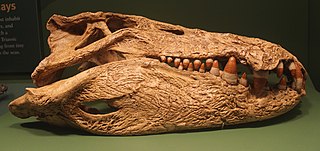
Mahajangasuchus is an extinct genus of crocodyliform which had blunt, conical teeth. The type species, M. insignis, lived during the Late Cretaceous; its fossils have been found in the Maevarano Formation in northern Madagascar. It was a fairly large predator, measuring up to 4 metres (13 ft) long.
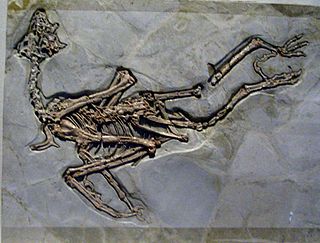
Omnivoropterygidae is a family of primitive avialans known exclusively from the Jiufotang Formation of China, though putative omnivoropterygids are known from the Maevarano Formation of the Maastrichtian of Madagascar. They had short skeletal tails and unusual skulls with teeth in the upper, but not lower, jaws. Their unique dentition has led some scientists to suggest an omnivorous diet for them. The family was named by Stephen A. Czerkas & Qiang Ji in 2002, though its junior synonym Sapeornithidae is often used instead, though it was named four years later in 2006. It is the only named family in the order Omnivoropterygiformes.

Madtsoia is an extinct genus of madtsoiid snakes. It is known from the Eocene of Argentina, the Paleocene of Brazil, the Late Cretaceous (Maastrichtian) of India, and the Late Cretaceous (Maastrichtian) of Madagascar. The type species was the largest with an estimated length of 9–10 m (30–33 ft), and the other three species were smaller. A 5.1 m (17 ft) long M. madagascariensis would have weighed 50 kg (110 lb), but an isolated specimen suggests that this species reached 8 m (26 ft) in maximum length.
Pitekunsaurus is a genus of titanosaurian sauropod dinosaur from the Late Cretaceous Anacleto Formation of Neuquén, Argentina. It was described by L. Filippi and A. Garrido in 2008. The type species is P. macayai. The generic name is derived from Mapudungun pitekun, meaning "to discover", the epitheton honours the discoverer, oil company explorer Luis Macaya, who found the fossil in April 2004.
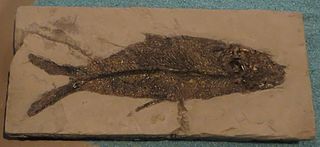
Aethalionopsis is an extinct genus of prehistoric freshwater bony fish from the Early Cretaceous of western Europe. Formerly classified as a species of the elopiform Anaethalion, it is now known to be a relative of the modern milkfish (Chanos) in order Gonorhynchiformes. It was previously placed as a basal member of the suborder Chanoidei, but is now more often placed as a basal member of the subfamily Chaninae of the family Chanidae, placing it closer to the extant Chanos.
Kinkonychelys is an extinct genus of side-necked turtle which existed in Madagascar during the Late Cretaceous period. It contains the single species Kinkonychelys rogersi, named in honor of its discoverer, Raymond R. Rogers. The genus and species are based on UA 9748, a nearly complete skull, which represents the first turtle skull described from the pre-Holocene era in Madagascar. A number of isolated skull and jaw bones have also been assigned to K. rogersi. These specimens were found in rocks of the Maastrichtian-age Maevarano Formation in the Mahajanga Basin of northwestern Madagascar. Another specimen, FMNH PR 2446, is speculated to represent another species, currently known as Kinkonychelys sp., but consensus on its distinction from K. rogersi remains unclear.
Kelyophis is an extinct genus of nigerophiid snake which existed in Madagascar during the Late Cretaceous. The type species is Kelyophis hechti. Trunk vertebrae have been found from the Maastrichtian-age Maevarano Formation in the Mahajanga Basin. Kelyophis is similar to other nigerophiids in its small size, long centra with posterior surfaces that deflect slightly downward, tubercular-shaped neural spines that are directed toward the back of the neural arches, and several other features of the vertebrae.
UA 8699 is a fossil mammalian tooth from the Cretaceous of Madagascar. A broken lower molar about 3.5 mm (0.14 in) long, it is from the Maastrichtian of the Maevarano Formation in northwestern Madagascar. Details of its crown morphology indicate that it is a boreosphenidan, a member of the group that includes living marsupials and placental mammals. David W. Krause, who first described the tooth in 2001, interpreted it as a marsupial on the basis of five shared characters, but in 2003 Averianov and others noted that all those are shared by zhelestid placentals and favored a close relationship between UA 8699 and the Spanish zhelestid Lainodon. Krause used the tooth as evidence that marsupials were present on the southern continents (Gondwana) as early as the late Cretaceous and Averianov and colleagues proposed that the tooth represented another example of faunal exchange between Africa and Europe at the time.
Vahiny is an extinct genus of titanosaur sauropod dinosaur known from the Late Cretaceous of the Maevarano Formation, northwestern Madagascar. It contains a single species, Vahiny depereti.

Pengornithidae is a group of early enantiornithines from the early Cretaceous Period of China, with the putative member Falcatakely possibly extending this clade's range into the Late Cretaceous of Madagascar, and several putative pengornithids also hail from this formation. Specimens of these animals have been found both in the Huajiying Formation and Jiufotang Formation of Liaoning and Hebei provinces, dating from the Hauterivian age to the Aptian age.

Falcatakely is an extinct genus of enantiornithean bird known from partial fossils from northern Madagascar. The genus contains a single species, Falcatakely forsterae.

Sahonachelys is an extinct genus of pelomedusoid turtle from the Late Cretaceous (Maastrichtian) Maevarano Formation of Madagascar. The genus contains a single species, Sahonachelys mailakavava.
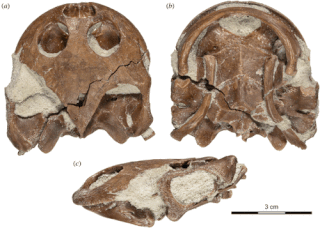
Sahonachelyidae is an extinct family of pelomedusoid turtles from the Late Cretaceous (Maastrichtian) Maevarano Formation of Madagascar. The clade was recognized in 2021 by Joyce et al., and contains two genera: Sahonachelys and Sokatra. The clade is characterized by the presence of a reduced contribution of the maxilla to the floor of the orbit, and, the presence of a distinct posterior process of the maxilla. The clade went extinct at the end of the Cretaceous period during the K-Pg extinction event.











